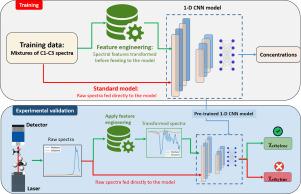Multi-component gas sensing via spectral feature engineering
IF 8
1区 化学
Q1 CHEMISTRY, ANALYTICAL
引用次数: 0
Abstract
We present a straightforward yet powerful spectral feature engineering technique designed to improve multi-species detection in complex mixtures. By applying convolutions of first derivatives with the composite spectra of target species before feeding the data into a convolutional neural network (CNN) model, this method significantly enhances the detection of weak absorbers and overlapping spectral features. To validate the approach, we developed a laser-based sensor that integrates wavelength tuning with a 1-D CNN model. The system utilizes a distributed feedback inter-band cascade laser operating near , enabling selective and simultaneous measurement of hydrocarbons. Experiments were conducted at ambient conditions with a temporal resolution of 10 ms, while (intentionally) keeping the signal-to-noise ratio at relatively low levels. Gaseous mixtures contained methane, ethane, propane and propyne ranging in mole fraction values of 0%–1%, and ethylene mole fraction below 200 ppm. Ethylene was deliberately kept at very low levels to demonstrate the effectiveness of the feature engineering technique in detecting a weak absorbing species. The proposed method reduced the mean squared error by ten times compared to standard models. This demonstrates its potential for accurate detection in challenging environments.


求助全文
约1分钟内获得全文
求助全文
来源期刊

Sensors and Actuators B: Chemical
工程技术-电化学
CiteScore
14.60
自引率
11.90%
发文量
1776
审稿时长
3.2 months
期刊介绍:
Sensors & Actuators, B: Chemical is an international journal focused on the research and development of chemical transducers. It covers chemical sensors and biosensors, chemical actuators, and analytical microsystems. The journal is interdisciplinary, aiming to publish original works showcasing substantial advancements beyond the current state of the art in these fields, with practical applicability to solving meaningful analytical problems. Review articles are accepted by invitation from an Editor of the journal.
 求助内容:
求助内容: 应助结果提醒方式:
应助结果提醒方式:


